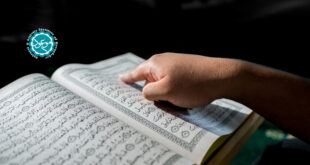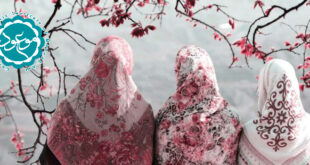Leaving embellishment, observing mourning and keeping hair disarranged
(A) The Prophet’s Sunnah is Practical
It is a practical Sunnah of the Messenger of Allah (s.a.w) to keep hair awry and to make a face of grief in mourning for Imam Husayn (a.s). Before I present some traditional report in this connection please read the following narration of Mishkatul Masabih, which is accepted by all.
(Sunni Tradition): The Messenger of Allah (s.a.w) said: One who sees me in a dream has actually seen me because the Satan can never appear in my form. This tradition is also universally accepted.
There are many traditions of the same topic and all are universally accepted. It is related from Abu Qatadah Ansari and Abu Huraira in the same chapter and the Shia also believe in it. Now see the following narrational report that Ibn Abbas is reported to have said that one day he was sleeping at home that the sound of weeping and lamentation from the house of Umme Salma, the wife of the Messenger of Allah (s.a.w) awoke him. He went towards Umme Salma’s residence and all Medinite folks also rushed there. Upon reaching there they asked her: ‘O Mother of believers! Why are you lamenting so much? Umme Salma did not give any reply. But she glanced towards the Hashemite ladies and said:
(Shia Tradition): “O daughters of Abdul Muttalib! Help me and join me in lamentation. Because, by Allah, your chief and the leader of the youths of Paradise has been martyred. The grandson of the Messenger of Allah (s.a.w) and his beloved one, Husayn, has been slain.”43
Ibn Abbas says that he asked Umme Salma how she came to know it. Umme Salma said: I have just seen the Messenger of Allah (s.a.w) in my dream. His face was covered with dust and he looked devastated. I asked him what the matter was and he said that his son, Husayn and his family have been massacred today. Hence, he has buried them and was just returning from their burial. Umme Salma says that after receiving this reply she arose and went inside the house and didn’t know what to do. ‘Suddenly I looked at the soil of Karbala’ that Jibraeel had brought.’ (Then she related the complete incident of Jibraeel). Thus when I looked at the bottle, I saw that the soil had turned into fresh blood which was boiling furiously.’ Ibn Abbas says that then Umme Salma took out some of this blood and smeared it on her face and that she observed the day as the day of mourning. She considered it a day for lamenting on Imam Husayn (a.s). After that (days later) messengers brought the news that Imam Husayn (a.s) had been martyred on that same day.
Such types of narrations are present in both Shia and Sunni books in large numbers. Thus we have quoted the account of the soil turning to blood from the marginal notes in our discussion about Ta’ziyah. In the book of Mishkat the incident of Umme Salma’s dream is mentioned in a report of Salma in brief on the authority of Sahih Tirmidhi. This report mentions the observing of Ma’tam. However, our aim of presenting this tradition is to prove that the Messenger of Allah (s.a.w) had his hair awry and his face was covered with dust due to his sorrow for Imam Husayn (a.s). Hence if our ladies or we also make our appearance thus, it is nothing but emulating the Sunnah of the Prophet. It could never be termed as an innovation.
(B) It is the Sunnah of Ahl al-Bayt (a.s)
Imam Ja’far Sadiq (a.s) said:
(Shia Tradition): “Neither any Hashemite lady comb her hair nor apply dye until Mukhtar sent the heads of the killers of Husayn (a.s) to us.”44
Black Clothes
Allamah Abu Ishaq Asfar Amini (renowned Sunni scholar) in his book, Noorul Ain Fi Mashhadil Husayn, Published Cairo, 1366 A.H. has quoted on Pg. 60 the report of the dream of Sakina. In this dream she saw the Messenger of Allah (s.a.w) in the following condition:
(Sunni Tradition): Suddenly I decried a gentleman, who moved forward in such a manner that the color of his face had changed and it was glowing. And due to the severity of his grief he was stumbling like a woman whose youthful son had died. He was holding his blessed beard, weeping and was in an aggrieved mood. I asked the servant who this gentleman was, dressed in mourning clothes and so much aggrieved? He said,“Didn’t you recognize him?” I said, no. He told me that it was my grandfather, the Messenger of Allah (s.a.w).
The condition in which she saw Lady Fatima (s.a.) is as follows:
“And among those ladies (Maryam and Asiya etc.) is a very prominent lady, having her hairs in disarray. She is wearing black clothes and she is holding a shirt smeared with blood.”
This clearly proves that the Messenger of Allah (s.a.w) was in mourning dress and Lady Fatima also had the hair in disarray and wore black clothes.
Silent Sunnah is from the Imam
We have already mentioned how Ahl al-Bayt (a.s) stayed in Damascus for seven days even after they were released and how they spent all this time in performing various rituals in mourning and lamentation for Imam Husayn (a.s).
(Shia Tradition): There was no Hashemite and Quraishi lady who did not don a black dress in grief of Imam Husayn (a.s).45
Mourning House (Azakhana)
The Imam’s Sunnah is Practical
The first mourning house that was made for Ahl al-Bayt (a.s) was the Baitul Ahzaan (House of lamentation) that Amir al-Mu’minin ‘Ali bin Abi Talib (a.s) had made for Lady Fatima who used to lament, day and night at the passing away of her blessed father. The people of Medina told Amir al-Mu’minin (a.s) to ask Lady Sayyida Fatima to either lament during the day or during the night. Lady Fatima said that she was going to stay among them only for a few days and that very soon she was going to say farewell to them. So, by Allah, she could neither remain silent during the day nor during the night could she stop weeping. Amir al-Mu’minin (a.s) said that she could lament whenever she desired. However, keeping in mind the disturbance for the people of Medina he made this arrangement.
(Shia Tradition): His Eminence, ‘Ali (a.s) constructed a house for Fatima in Baqi on the outskirts of Medina, which became known as Baitul Ahzaan (House of lamentation). In the morning, Lady Fatima used to go weeping towards Baqi with Hasan and Husayn (a.s) and she used to sit in that graveyard and lament. When night fell, Amir al-Mu’minin (a.s) used to go and bring her home…until the end of the tradition.46
This incident is also mentioned in the books of Ahl al-Sunnah and books of history. This shows that construction of Azakhanas is practice of ‘Ali (a.s).
Arena, drums and lashing with chains
Under the tenth heading I would like to discuss about three things that are sometimes a part of Muharram processions but regarding which there is a difference of opinion among the Shia scholars that whether they could be justified to be part of mourning rituals or not. Or whether they fall under the lawful category of actions or not. If so, under what justifications can they be considered lawful?
However, the most important point is that whatever may be the position of the Shia scholars in this matter, traditions of Ahl al-Sunnah prove beyond any doubt that all these things were permitted by the Holy Prophet (s.a.w), hence neither the Ahl al-Sunnah people nor the officers of Tanzeem Ahl al-Sunnah have any right to say anything against these rituals.
(A) Watching an Arena is Sunnah of the Prophet
Let us see the following tradition that Tirmidhi has judged to be authentic and correct:
(Sunni Tradition): Ayesha is reported to have said that one day the Messenger of Allah (s.a.w) was sitting when we heard a clamor and noise of children. So the Messenger of Allah (s.a.w) arose and we saw that a black woman was dancing and children had gathered around her. So the Messenger of Allah (s.a.w) said: Ayesha, come and see. I came and kept my chin on the shoulder of the Holy Prophet (s.a.w) and began to peep through the gap between his blessed head and shoulder. Then the Holy Prophet (s.a.w) asked me: Are you not satisfied yet? I kept telling him ‘no’ to see how much he cared for me…(until the end of the report).47
This tradition mentions dancing and the marginal notes on this on the authority of Lumah say:
(Statement of Ahl al-Sunnah scholars): But it is not unlawful, because if it had been so, how the Messenger of Allah (s.a.w) would have watched it and how he could have allowed Ayesha to watch it?
However, becoming helpless due to the objections of Shias they have interpreted that it was not a dance; it was a display of the art of warfare, that is a ‘wrestling ring’. That is why the Holy Prophet (s.a.w) watched it himself and also told Ayesha to watch it. If we accept this interpretation it would clearly justify watching wrestling matches because what it is except display of the art of warfare? And if we don’t accept this interpretation, even then, in comparison to dancing, a wrestling match is not a serious act and in some cases it becomes a recommended thing. No objection can be directed against it.
Check Also
15 European Countries With Most Muslims
According to Mouood, quoting by World Atlas: 15 European Countries With Most Muslims By 2050, Muslims …
 Mouood Mouood English Edition
Mouood Mouood English Edition



